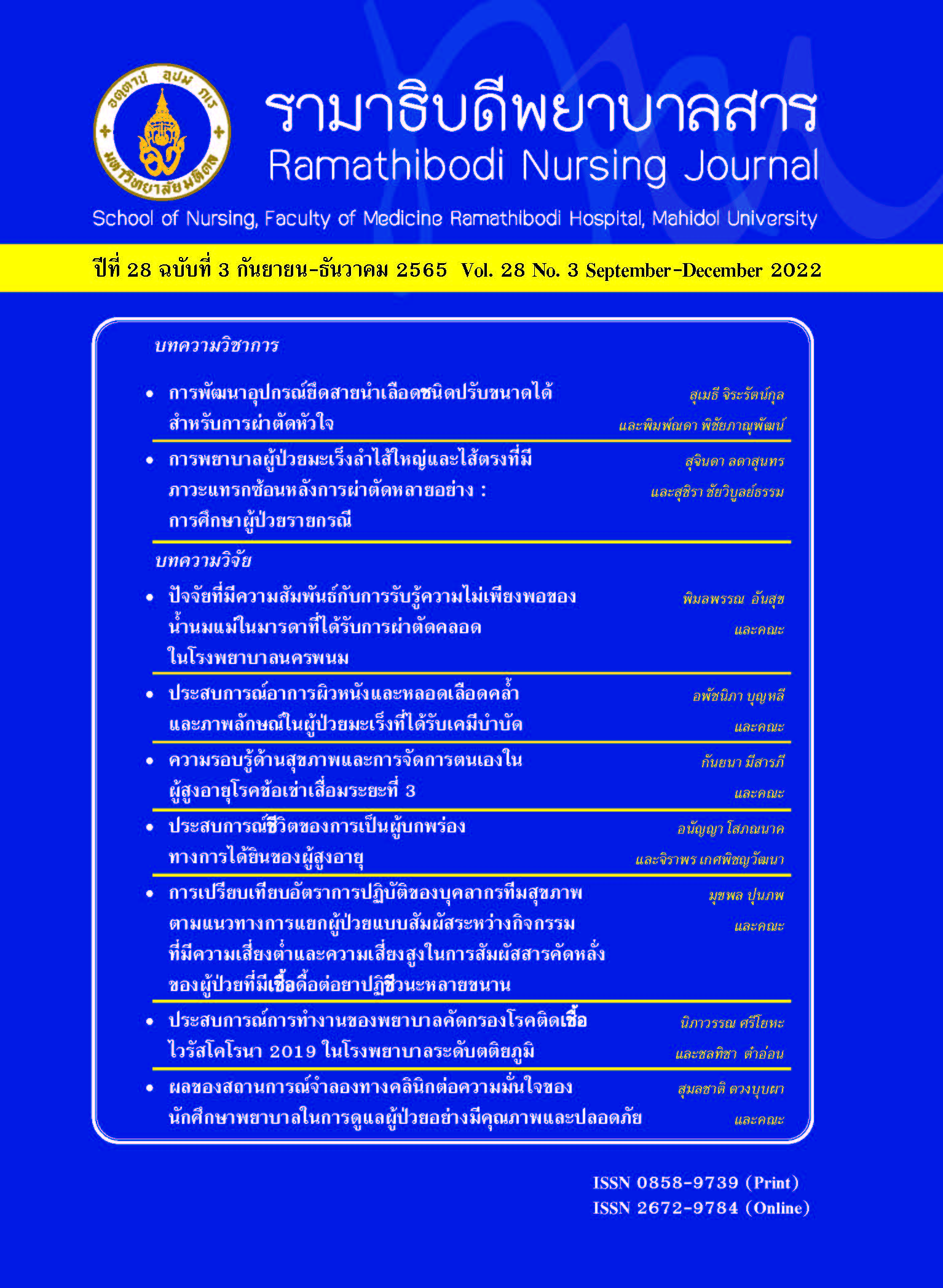Lived Experiences of Being Hearing Impaired Older People
Main Article Content
Abstract
Abstract
This research aimed to study the lived experiences of hearing-impaired older people using a qualitative study method based on phenomenology. The key informants were seventeen older people with hearing impairment, selected through the purposive sampling method. Data were collected through in-depth interviews, observation, and field notes. The results revealed four main categories: 1) perception of hearing impairment, 2) the older people’s lives changed when they became hearing-impaired people, 3) expression of other people to hearing-impaired older people, and 4) the adaptation to be the older people with hearing impairment. The results of this research can be used to provide basic information for health team personnel to understand the life experiences of hearing-impaired older people. They can be used to develop nursing guidelines to be more effective as well.
Keywords: Lived experiences, Phenomenology, Older people, Hearing impairment
Article Details

This work is licensed under a Creative Commons Attribution-NonCommercial-NoDerivatives 4.0 International License.
บทความ ข้อมูล เนื้อหา รูปภาพ ฯลฯ ที่ได้รับการตีพิมพ์ในรามาธิบดีพยาบาลสาร ถือเป็นลิขสิทธิ์ของวารสาร หากบุคคลหรือหน่วยงานใดต้องการนำทั้งหมดหรือส่วนหนึ่งส่วนใดไปเผยแพร่หรือเพื่อกระทำการใด ใด จะต้องได้รับอนุญาตเป็นลายลักษณ์อักษรจากรามาธิบดีพยาบาลสารก่อนเท่านั้น
References
Sprinzl GM, Riechelmann H. Current trends in treating hearing loss in elderly people: a review of the technology and treatment options-a mini-review. Gerontology.2010;56(3):351-8.
Foundation of Thai Gerontology Research and Development Institute (TGRI). Situation of the Thai elderly 2017,English ed. Bangkok: Institute for Population and Social Research, Mahidol University; 2017.
Foundation of Thai Gerontology Research and Development Institute (TGRI). Situation of the Thai elderly 2019,English ed. Bangkok: Institute for Population and Social Research, Mahidol University; 2019.
Ronnarithivichai C. Changes in the body and mind of the elderly [Internet]. Bangkok: Folk Doctor; 1987 [updated September 1; cited 2021 March 30]. Available from:https://www.doctor.or.th/article/detail/4930 (in Thai)
Nash SD, Cruickshanks KJ, Klein R, Klein BE, Nieto FJ,Huang GH, et al. The prevalence of hearing impairment and associated risk factors: the Beaver Dam offspring study. Arch Otolaryngol Head Neck Surg.2011;137(5):432-9.
Harkin H, Kelleher C. Caring for older adults with hearing loss. Nurs Older People. 2011;23(9):22-8.
Gates GA, Couropmitree NN, Myers RH. Genetic associations in age-related hearing thresholds. Arch Otolaryngol Head Neck Surg. 1999;125(6):654-9.
Helzner EP, Patel AS, Pratt S, Sutton-Tyrrell K, Cauley JA, Talbott E, et al. Hearing sensitivity in older adults:associations with cardiovascular risk factors in the health,aging and body composition study. J Am Geriatr Soc.2011;59(6):972-9.
World Health Organization. Situation review and update on deafness, hearing loss and intervention programmes.New Delhi: World Health Organization Regional Office for South-East Asia; 2007.
Lin FR, Metter EJ, O’Brien RJ, Resnick SM, Zonderman AB, Ferrucci L. Hearing loss and incident dementia. Arch Neurol. 2011;68(2):214-20.
Lawrence BJ, Jayakody DMP, Bennett RJ, Eikelboom RH, Gasson N, Friedland PL. Hearing loss and depression in older adults: a systematic review and meta-analysis.Gerontologist. 2020;60(3):e137-e54.
Li-Korotky HS. Age-related hearing loss: quality of care for quality of life. Gerontologist. 2012;52(2):265-71.
Deal JA, Reed NS, Kravetz AD, Weinreich H, Yeh C, LinFR, et al. Incident hearing loss and comorbidity: a longitudinal administrative claims study. JAMA Otolaryngol Head Neck Surg. 2019;145(1):36-43.
Report on the 2014 survey of the older persons in Thailand.Bangkok: National Statistical Office; 2557. (in Thai)
Lubbers CA, Roy SJ. Communication Skills for Continuing Education in Nursing. J Contin Educ Nurs. 1990;21(3):109-12.
Streubert HJ, Carpenter DR. Qualitative research in nursing advance the humanistic imperative. 5th ed. New York:Lipponcott Williams & Wilkins; 2011.
Colaizzi PF. Psychological research as the phenomenologist views it. In: Valle R, King M, editors. London: Oxford University Press; 1978.
Guba EG. Naturalistic inquiry. California: SAGE; 1985.
Saxon SV, Etten MJ, Perkins EA. Physical change and aging: a guide for the helping professions. New York:Springer Publishing Company; 2014.
Thongcharoen V. Aspect of illness and concept of elderly care. In: Thongcharoen V, editor. Science and art in elderly care. Bangkok: Textbooks Project, Faculty of Nursing,Mahidol University; 2554. p. 24-42. (in Thai)
Patel R, McKinnon BJ. Hearing loss in the elderly. Clin Geriatr Med. 2018;34(2):163-74.
Gates GA, Anderson ML, McCurry SM, Feeney MP,Larson EB. Central auditory dysfunction as a harbinger of Alzheimer dementia. Arch Otolaryngol Head Neck Surg.2011;137(4):390-5.
Sestic MR, Miličević S. Satisfaction with a hearing aid and socioemotional problems of elderly people with hearing loss. Annals of the Faculty of Engineering Hunedoara.2013;11(4):189-92.
Blazer DG. Hearing loss: the silent risk for psychiatric disorders in late life. Clin Geriatr Med. 2020;36(2):201- 9.
Ajrouch KJ, Fuller HR, Akiyama H, Antonucci TC.Convoys of social relations in cross-national context.Gerontologist. 2018;58(3):488-99.
Hallberg LR, Barrenäs ML. Living with a male with noiseinduced hearing loss: experiences from the perspective of spouses. Br J Audiol. 1993;27(4):255-61.
Echalier M. A world of silence: the case for tackling hearing loss in care homes. England: Action on Hearing Loss;2012.
West JS. Hearing impairment and mental health among married couples. J Gerontol B Psycho Sci Soc Sci.2020;76(5):933-43.
Morgan SD, Ferguson SH. Judgments of emotion in clear and conversational speech by young adults with normal hearing and older adults with hearing impairment. J Speech Lang Hear Res. 2017;60(8):2271-80.
Stevens MN, Dubno JR, Wallhagen MI, Tucci DL. Communication and healthcare: self-reports of people with hearing loss in primary care settings. Clin Gerontol.2019;42(5):485-94.
Hearing aids [Internet]. Maryland: National Institute on Deafness and Other Communication Disorders; 2017[cited 2021 March 9]. Available from: https://www.nidcd.nih.gov/health/hearing-aids
Salonen J, Johansson R, Karjalainen S, Vahlberg T, Jero JP, Isoaho R. Hearing aid compliance in the elderly. B-Ent.2013;9(1):23-8.
Kongtangchit P. Hearing aid fitting procedure in the Pathumthani Hospital. Thammasat Medical Journal.2013;13(4):465-76. (in Thai)
Dawes P, Cruickshanks KJ, Fischer ME, Klein BE, KleinR, Nondahl DM. Hearing-aid use and long-term health outcomes: hearing handicap, mental health, social engagement, cognitive function, physical health, and mortality. Int J Audiol. 2015;54(11):838-44.
Lerttrakarnnon P, Uttawichai K, Aramrattana A, Boonyanukul S. Factors related to the compliance of elderly on regularly use of hearing aids. Chiang Mai Med Bull.1998;37(3-4):59-68. (in Thai)
Gilsdorf JR. Silence: what caused Helen Keller’s deafblindness? Clin Infect Dis. 2018;67(9):1445-9.
White AM, Philogene GS, Fine L, Sinha S. Social support and self-reported health status of older adults in the United States. Am J Public Health. 2009;99(10):1872-8.
Ko J. Presbycusis and its management. Br J Nurs.2010;19(3):160-5.


